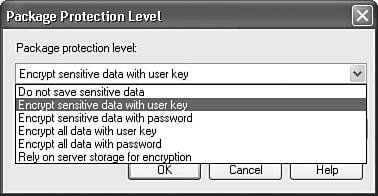Protecting Packages and Other Files
| SSIS pulls together the concepts of sensitive data identification and encryption by providing six package-protection options. Figure 18.6 shows the dialog box you use to select the appropriate package-protection option whenever you save a package to file or SQL Server, whether you're using the SSIS Import/Export Wizard, DTExecUI, or SQL Server 2005 Management Studio. Figure 18.6. The Package Protection Level selection dialog box The package protection levels are also available in the designer property grid for packages. Tip Make sure you click on the package control flow design surface before you look at the property grid. You should see the option to select the ProtectionLevel, as shown in Figure 18.7. Figure 18.7. Selecting the package protection level in the property grid The Package Protection LevelsFollowing is a brief description of each of the package protection levels.
Table 18.3 gives a little more information about each of the package protection levels. Note that when using server storage, the sensitive data is left in the package. SQL Server 2005 provides an encrypted channel and SSIS uses it to protect the package and all sensitive data en route to the server.
Note If you save with one of the sensitive options Encrypt Sensitive Data with Password, Encrypt Sensitive Data with User Key, or Do Not Save Sensitive Datathe package XML will be visible in the designer, so you can recover it if you forget the password or are no longer able to log in as the person who created the package. This tidbit is good to know if you're ever concerned about impending layoffs, disgruntled package developers, or just long-term accessibility of packages and you're not too concerned about losing the intellectual property in your packages. Encrypting the entire package is a safer way of protecting everything in the package, but it also carries more risk than protecting only the sensitive data. If a user-key password is lost or the person who wrote the package leaves and you can't log in with the original credentials, the package is lost for good. No one, including Microsoft, can do anything to recover the package in such a situation. For some packages, such a loss might not be a problem, but it is good to be aware of the risks associated with full encryption. SSIS lets you use either the user key or a password to encrypt an entire package or just parts of the package. Like your login password, an encryption password can be any password you create. However, Windows generates the user key and you cannot change it. The user key is ideal when you want to protect a package that only you will run. For example, it is a great option when developing packages because you don't need to repeatedly type in a password. The drawback to encrypting packages with a user key is that other users can't open the package unless they log in with the original package creator's credentials. Using a password is more flexible and can add secondary protection to packages, but requires you to type in the password every time you open the package.
Caution It is important to understand the implications of using the user key encryption methods. Because the user key is used to generate the decryption key, if by chance, you ever forget your system login password and must have the system administrator perform a password reset, you will be unable to decrypt any packages that were encrypted with the EncryptAllWithUserKey protection level. This is really no different than if you forget the password used to encrypt a package with one significant exception: If you forget the password you used to encrypt the package, it's obvious to you and you chalk it up to bad memory. Because the user key encryption methods are somewhat transparent to you as an SSIS user, if you forget your system login password, and you have your password reset, it simply appears that your packages were corrupted somehow. And it only happens when you attempt to open the package after the next time you log in. Figure 18.8 shows the error you receive when attempting to load a package encrypted with the user key after resetting your login password. Use EncryptAllWithUserKey carefully. Figure 18.8. Attempting to load an encrypted package after resetting the system login password Protecting Nonpackage FilesPackage encryption only protects the contents of packages and does not protect other files the package generates, such as log files, checkpoint files, or configuration files. Also, child packages do not inherit package protection levels from their parents. Depending on the package and the kind of data you store in variables, you might want to consider encrypting them or storing them in a secured folder. For example, checkpoint files contain the contents of variables in the package at the last checkpoint saved. If the package is processing Visa numbers or medical records when the package fails, it might be important that you protect the resulting checkpoint file. For protecting log files and configurations, the easiest way, in many cases, is to use the SQL Server variant. So, for configurations, use SQL Server Configurations and for logging, use SQL Server Logging. But there is no SQL Server variant of checkpoint files, so for checkpoint files you need to secure the folder in which they are stored using file system security, as described previously. |
EAN: 2147483647
Pages: 200

